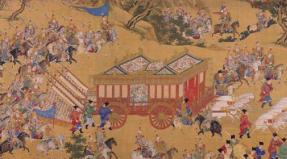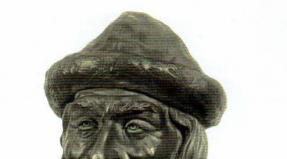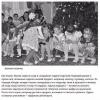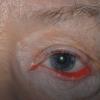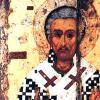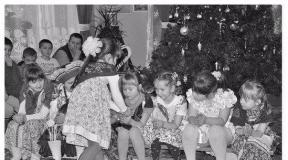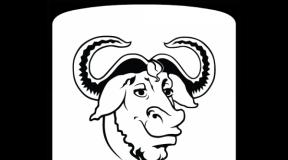Creation of the Ukrainian Insurgent Army UPA. Hero of ukraine bandera and the crimes of oun-upa
To begin with, a brief educational program - based on Wikipedia and slovari.yandex.ru:
Stepan Andreevich Bandera(Ukrainian Stepan Andriyovich Bandera) (January 1, 1909 - October 15, 1959) - one of the leaders of the Ukrainian nationalist movement in Eastern Poland (Galicia), Hero of Ukraine (2010), in 1941-1959 head of the Organization of Ukrainian Nationalists (OUN (b)) .
Organization of Ukrainian Nationalists (OUN)- a terrorist organization of a nationalist persuasion, operating in the western regions of Ukraine in the 20-50s. 20th century It emerged in 1929 as the "Ukrainian Military Organization" (UVO), then changed its name. The founder and first leader of the OUN was Evgen Konovalets, a former colonel in the Austro-Hungarian army. During the years of the Revolution of 1917 and the Civil War, he actively participated in the nationalist movement in Ukraine, together with S. Petliura. At one time he served as the military commandant of Kiev. The ideological platform of the OUN was the concepts of radical Ukrainian nationalism, distinguished by chauvinism and xenophobia, which had a pronounced anti-Russian orientation and focused on the use of extremist means to achieve the goal - the creation of "independent", "square" Ukraine.
After the Red Army entered the territory of Western Ukraine and Western Belarus in September 1939, the OUN, in cooperation with German intelligence agencies, began the fight against Soviet power. The preservation of the influence of the nationalists was largely facilitated by the methods by which the communist regime was imposed on the Western Ukrainian lands. Ukrainian nationalists warmly welcomed the attack of fascist Germany on the USSR and from the first days of the war supported the German troops and the occupation authorities. Members of the OUN helped the German fascists in the "final solution of the Jewish question", that is, the destruction and deportation of Jews in the occupied territories, served in the occupation administration and the police. Even when it became completely clear that Hitler would not grant Ukraine any semblance of "independence", the nationalists did not stop cooperating with the Nazis. With their active support, the SS division "Galicia" was formed.
The Ukrainian Insurgent Army (UPA) is an armed formation of the Organization of Ukrainian Nationalists.
It operated from the spring of 1943 in the territories that were part of the General Government (Galicia - from the end of 1943, the Kholm region - from the autumn of 1943), the Reichskommissariat Ukraine (Volyn - from the end of March 1943), and the Romanian Transnistria (Transnistria) (Northern Bukovina - from summer 1944), which until 1939-1940 were part of Poland and Romania.
In 1943-44. UPA detachments carried out ethnic cleansing of the Polish population in Western Volyn, Kholmshchyna and Eastern Galicia.
In 1943-1944, UPA detachments acted against Soviet partisans and detachments of the Polish underground (both communist and subordinate to the London government, i.e. Home Army).
But about the crimes of the UPA.
The UPA was established on October 14, 1942 by decision of the leadership of the Organization of Ukrainian Nationalists (OUN). It was headed by Roman Shukhevych, a holder of two knightly orders of Nazi Germany. President Yushchenko declared him a hero of Ukraine, and from the UPA itself he is trying to represent a belligerent during the Second World War.
Meanwhile, there is not a single document testifying that the UPA units fought with large Wehrmacht forces. But there are more than enough documents on the joint actions of Ukrainian nationalists with the Nazis. And even more documents tell about the savagery that the "national hero" Roman Shukhevych and his brothers in arms did.
It is known for sure that the published newspaper Surma, bulletins and other nationalist literature were printed in Germany. Part of the nationalist literature was illegally published in Lvov and other cities of Western Ukraine. Recently, the Russian Foreign Ministry published documents. Here are some of them:
The head of the 4th Directorate of the NKVD of the USSR, Pavel Sudoplatov, in a message dated December 5, 1942, testifies: “Ukrainian nationalists, who were previously underground, met the Germans with bread and salt and provided them with all kinds of help. The German occupiers widely used the nationalists to organize the so-called "new order" in the occupied regions of the Ukrainian SSR.
From the Protocol of interrogation of Kutkovets Ivan Tikhonovich, an active Banderite. February 1, 1944:
“Despite the fact that, at the behest of the Germans, Bandera proclaimed an “independent” Ukraine, but the Germans delayed the issue of creating a national Ukrainian government ... It was unprofitable for the Germans to create a Ukrainian national government, they “conquered” Ukraine and considered it an eastern colony of the “Third Empire” and power over They did not want to share Ukraine with Bandera, and they removed this rival. In addition, at that time, the Ukrainian police, created by the OUN, carried out an active security service in the rear of the German army to fight partisans, to detain Soviet paratroopers and to look for Soviet party activists.
Worthy of attention is the circular "On the Treatment of Members of the UPA" issued on 12.2.44 by the so-called Prützmann Fighting Group. From it it is clear how the UPA "fought" with the Germans a year and a half after its creation:
“Negotiations that began in the Derazhnya region with the leaders of the nationalist Ukrainian Insurgent Army are now also continuing in the Verba region. We agreed: members of the UPA will not attack German military units. The UPA is currently sending scouts, mostly girls, to the territory occupied by the enemy and reporting the results to the representative of the intelligence department of the combat group. Captured Red Army soldiers, as well as captured persons belonging to Soviet gangs, will be delivered to a representative of the intelligence department for interrogation, and the alien element will be transferred to the combat group for assignment to various work. In order not to interfere with this cooperation, which is necessary for us, it is ordered:
1. UPA agents who have certificates signed by a certain “Captain Felix”, or pretend to be members of the UPA, let them through freely, leave their weapons to them. Upon request, agents must be immediately brought to the 1st (representative of the intelligence department) battle group.
2. Parts of the UPA, when meeting with German units for identification, raise their left outstretched hand to their faces, in which case they will not be attacked, but this can happen if fire is opened from the opposite side ...
Signed: Brenner, Major General and SS Brigadeführer.
Another "heroic" stage in the history of Ukrainian nationalists and personally UPA commander Roman Shukhevych is the fight against Belarusian partisans. Historian S.I. Drobyazko in his book “Under the banner of the enemy. Anti-Soviet formations in the German armed forces” writes that in 1941 on the territory of Belarus the first Ukrainian police battalions were already formed from prisoners of war of the Red Army.
“Most of the Ukrainian battalions of the auxiliary police carried out security service on the territory of the Reichskommissariats, others were used in anti-partisan operations - mainly in Belarus, where, in addition to the battalions already created here, a number of units were sent from Ukraine, including 101, 102, 109, 115, 118 , 136th, 137th and 201st battalions.
Their actions, as well as the actions of other similar units involved in punitive actions, were associated with numerous war crimes against the civilian population. The most famous of which was the participation of a company of the 118th battalion under the command of cornet V. Meleshko in the destruction of the village of Khatyn on March 22, 1943, when 149 civilians died, half of whom were children,” he writes.
And now - the word to Bandera themselves. Here is what was published in 1991 in No. 8 of the Vizvolny Shlyakh edition, which was published in London:
“In Belarus, the 201st Ukrainian battalion was not concentrated in one place. His soldiers in couples and hundreds were scattered over different strongholds .... After arriving in Belarus, the kuren received the task of guarding the bridges on the Berezina and Zapadnaya Dvina rivers. The departments stationed in settlements were charged with the duty to protect the German administration. In addition, they had to constantly comb through the forests, identify and destroy partisan bases and camps, ”writes Bandera M. Kalba in this publication.
“Each hundred guarded the square allotted to it. The 3rd hundred of lieutenant Sidor were in the south of the zone of responsibility of the Ukrainian battalion, the 1st hundred of ROMAN SHUKHEVICH was in the center ... Pursuing the partisans in unfamiliar territory, the soldiers fell into an enemy ambush and were blown up by mines ... The battalion spent nine months on the "partisan front" and gained invaluable combat experience in this struggle. According to approximate data, the legionnaires destroyed more than two thousand Soviet partisans,” he notes.
As they say, no comment. Even the Banderaites themselves directly indicate what the “national hero” Shukhevych was doing in Belarus. For what kind of Ukraine he fought against the fraternal Belarusian people - one can only guess.
Finally, in 1943-1944. UPA detachments in Volhynia and Galicia exterminated over 100 thousand Poles. The Polish publication “Na Rubieїy” (Nr 35, 1999), published by the Volyn Foundation, describes 135 methods of torture and atrocities that the UPA fighters used against the Polish civilian population, including children.
Here are just a few of those fanatics:
001. Driving a large and thick nail into the skull of the head.
002. Stripping hair from the head with skin (scalping).
003. Striking with the butt of an ax on the skull of the head ...
005. Carving on the forehead "eagle" (Polish coat of arms) ...
006. Driving a bayonet into the temple of the head. ..
012. Piercing children with stakes through and through.
016. Cutting the throat….
022
023. Cutting the neck with a knife or sickle….
024. Striking with an ax in the neck ...
039. Cutting off women's breasts with a sickle.
040. Cutting off women's breasts and sprinkling salt on wounds.
041. Cutting off the genitals of male victims with a sickle.
042. Sawing the body in half with a carpenter's saw.
043. Infliction of stab wounds to the abdomen with a knife or bayonet.
044. Punching the belly of a pregnant woman with a bayonet.
045. Cutting the abdomen and pulling out the intestines in adults ...
069. Sawing a body lined with boards on both sides, in half with a carpenter's saw...
070. Sawing the body in half with a special saw.
079. Nailing the tongue of a small child to the table with a knife, which later hung on it ....
080. Cutting a child into pieces with a knife and throwing them around ...
090. Hanging a monk by his feet near the pulpit in the church.
091. Planting a child on a stake.
092. Hanging a woman upside down on a tree and mocking her - cutting off her chest and tongue, dissecting her stomach, gouging out her eyes, and cutting off pieces of her body with knives ...
109. Tearing the torso with chains...
126. Cutting the skin from the face with blades ...
133. Nailing hands to the threshold of the dwelling ...
135. Dragging a body along the ground by legs tied with a rope.
We only add that the list of UPA crimes is by no means limited to this. Russians, Czechs, Jews became their victims, but most of all... the Ukrainians themselves, who did not actively cooperate with them.
In Ukraine, 5 million 300 thousand civilians died at the hands of the Nazis, 2 million 300 thousand able-bodied Ukrainian women and Ukrainians were driven to Germany.
850,000 Jews, 220,000 Poles, more than 400,000 Soviet prisoners of war, and another 500,000 civilian Ukrainians died at the hands of punishers - Bandera. 20 thousand soldiers and officers of the Soviet Army and law enforcement agencies were killed, approximately 4-5 thousand of their own "warriors" of the UPA, who were not "active and nationally conscious" enough.
June 30, 1941. The Nachtigall Battalion under the command of R. Shukhevych, who broke into the city of Lvov at dawn together with the German advanced units, in the first days destroyed more than 3 thousand Poles from Lvov, including 70 world-famous scientists. And within a week, R. Shukhevych's "Nachtigal" battalion brutally annihilated about 7,000 civilians, including children, women, and the elderly. Metropolitan Andrei Sheptytsky held a divine service in the courtyard of the Svyatoyura Cathedral in honor of "the invincible German army and its chief leader, Adolf Hitler." With the blessing of the head of the Ukrainian Greek Catholic Church, the mass extermination of civilians in Ukraine by Bandera, Nakhtigalev, Upovtsy and warriors of the SS division "Galicia" began. 
R. Shukhevych.
Created with the beginning of the Great Patriotic War by an Abwehr agent, a member of the Chernivtsi regional OUN wire, Voynovsky, Bukovinsky kuren (about 500 people) arrived in Kiev on September 22, 1941, where from September 28 he took part in the massacre of innocent people of different nationalities in BABY YARU. Then 350 thousand people were deprived of their lives, including 160 thousand Jews, of which 50 thousand were children! And not only took part, but was the main executor of this bloody battle. For these atrocities and cannibalism, for zeal in the service of fascism, Voinovsky was awarded the rank of SS major.
Among the 1,500 punishers at Babi Yar, there were 1,200 policemen from the OUN and only 300 Germans! 
At the beginning of 1942, the Nachtigal battalion was reorganized into the 201st SS police battalion and, led by Captain Shukhevych, was sent to Belarus to fight partisans. It was the Nakhtigalevites who wiped off the face of the earth the Belarusian village of KHATYN, the Volyn village of KORBELISY, in which over 2,800 civilians were killed and burned, mostly children, women, the elderly and the sick.
On February 9, 1943, Bandera from the gang of Pyotr Netovich, under the guise of Soviet partisans, entered the Polish village of Parosle near Vladimirets, Rivne region. The peasants, who had previously provided assistance to the partisans, warmly welcomed the guests. After eating plenty, the bandits began to rape women and girls. Before they were killed, their chests, noses and ears were cut off. Then they began to torture the rest of the villagers. Men were stripped of their genitals before they died. Finished off with blows of an ax on the head. 
Two teenagers, the Gorshkevich brothers, who tried to call real partisans for help, had their stomachs cut open, their legs and arms cut off, their wounds were abundantly covered with salt, leaving the half-dead to die in the field. In total, 173 people, including 43 children, were brutally tortured in this village.
In one of the houses on the table among the leftovers and unfinished bottles of moonshine lay a dead one-year-old child, whose naked body was nailed to the table boards with a bayonet. The monsters put a half-eaten pickled cucumber into his mouth.
March 1943 In the outskirts of Huta Stepanska, Stepan commune, Kostopil district, Ukrainian nationalists stole 18 Polish girls by deception, who were killed after being raped. The bodies of the girls were placed side by side, and a ribbon was placed on them with the inscription: “This is how the frogs should die.” 
On March 7, 1943, in the district of Terazh (Lutsk district), Bandera captured several Polish children in the pasture, who were muzzled in the nearest forest.
On May 5, 1943, in Lipniki (Kostopol district), three-year-old Stasik Pavlyuk was smashed in the head against the wall, holding him by the legs.
On June 8, 1943, in the village of Chertozh-Vodnik (Rivne district), the upovtsy, in the absence of their parents' home, muzzled the three children of the Bronevskys: Vladislav, 14 years old, Elena, 10 years old, and Henry, 12 years old.
On July 11, 1943, during the service of God, Bandera attacked the village of Osmigovichi and killed believers. A week later, our village was attacked... The little children were thrown into the well, and the big ones were locked up in the basement and filled up. One Banderite, holding the baby by the legs, hit his head against the wall. The mother of that baby screamed until she was pierced with a bayonet.
July 11, 1943 Biskupichi village, Mykulichi commune, Vladimir-Volynsky district. Ukrainian nationalists committed a massacre, herding residents into a school building. Then the family of Vladislav Yaskula was brutally murdered. The executioners broke into the house when everyone was asleep. Parents and five children were killed with axes, they were all put together, covered with straw from mattresses and set on fire.
On July 11, in Kalusovo (Vladimir district), during the massacre, the Upovites muzzled the two-month-old baby Iosif Fili, tore him by the legs, and put the parts of the calf on the table. 
July 12, 1943 Colonia Maria Volya, commune Mykulychi, Vladimir-Volynsky district. Around 15.00, Ukrainian nationalists surrounded her and began to muzzle the Poles, using firearms, axes, knives, pitchforks and sticks. About 200 people (45 families) died. Some of the people, about 30 people, were thrown alive into a well and there they were killed with stones. Those who fled were chased down and finished off. During this massacre, the Ukrainian Didukh was ordered to kill a Polish woman and two children. When he did not comply with the order, they killed him, his wife and two children. Eighteen children aged 3 to 12, who hid in the grain fields, were caught by the criminals, put on a bed cart, brought to the village of Chestny Krest and killed there, punched with pitchforks, chopped with axes. The action was led by Kwasnitsky.
August 29-30, 1943, by order of the commander of the so-called military district of the OUN "Oleg" on
On the territory of Kovelsky, Lyubomlsky and Turinsky districts of the Volyn region, several hundred people of the UPA under the leadership of Yury Stelmashchuk massacred the entire Polish population. They plundered all their property and burned their farms. In total, in these areas on August 29 and 30, 1943, more than 15 thousand people were slaughtered and shot by Bandera, among whom there were many elderly people, women and children. 
They drove the entire population to one place without exception, surrounded it and began the massacre. After there was not a single living person left, they dug large pits, dumped all the corpses into them and covered them with earth. To hide the traces of this terrible action, we kindled fires on the graves. So they completely destroyed dozens of small villages and farms ... "
In mid-September 1943, about 3,000 residents of Polish nationality were killed and stabbed to death by UPA gangs in the Gorokhovsky and former Senkivichsky districts of the Volyn region. It is characteristic that one of the groups of the UPA was led by a priest of the autocephalous church, who was in the OUN, who absolved his flock of sins for the atrocities committed. People were laid on the ground in rows, face down, and then shot. Once again laying down people for execution, a Bandera man shot a 3-4-year-old boy. The bullet blew off the top of his skull. The child got up, began to scream and run from one side to the other with an open pulsating brain. Bandera continued to shoot, and the child ran until the next bullet calmed him ...
On November 11, 1943, on the orders of commander Laidaki, one hundred (company. Auth.), led by Nedotypolsky, went to liquidate the Polish colony Khvashchevat. The whole colony was burned, 10 Poles were killed... 45 horses were taken away... 
In the autumn of 1943, the soldiers of the "army of the immortals" killed dozens of Polish children in the village of Lozova, Ternopil district. In the alley, they "decorated" the trunk of each tree with the corpse of a child who had been killed before.
According to Western researcher Alexander Korman, the corpses were nailed to trees in such a way as to create the appearance of a “wreath”.
Yu.Kh. from Poland: “In March 1944, our village of Guta Shklyana, commune Lopatyn, was attacked by Bandera, among them was one named Didukh from the village of Oglyadov. Five people were killed, cut in half. A minor was raped."
March 16, 1944 Stanislavshchina: group "L" and group "Garkusha" in the amount of 30 persons destroyed 25 Poles ...
On March 19, 1944, a group "L" and a county fighter in the amount of 23 people held an action in the village. Zelenivka (Tovmachchin). 13 farms were burned, 16 Poles were killed. 
On March 28, 1944, Sulima's group of 30 people destroyed 18 Poles ...
On March 29, 1944, the Semyon group liquidated 12 Poles in Pererosl and burned 18 farms ...
April 1, 1944 Ternopil region: killed in the village. White 19 Poles, 11 households burned
April 2, 1944 Ternopil region: nine Poles were killed, two Jewish women who were in the service of the Poles ...
On April 5, 1944, the Zaliznyak regional group carried out an action in Porogy and Yablintsy. Six houses were burned, 16 Poles were destroyed ...
April 5, 1944 Kholmshchina: the groups "Galaida" and "Tigers" carried out a liquidation action against the colonies: Gubynok, Lupche, Polediv, Zharnyki ... In addition, the self-defense group "Fox" destroyed the colony Marysin and Radkiv, and the Orla group - Polish colonies in Riplyn. Several dozen Polish soldiers and many civilians were killed.” 
On April 9, 1944, the Nechay group liquidated in the village. Pasichnaya 25 Poles...
On April 11, 1944, the Dovbush group liquidated 81 Poles in Rafaylovo.
April 14, 1944 Ternopil region: 38 Poles were killed...
April 15, 1944 in the village. Fat 66 Poles were killed, 23 households were burned...
On April 16, 1944, the Dovbush group liquidated in the village. Green 20 Poles...”.
On April 27, 1944, the district fighting liquidated 55 men and five women Poles in the village of Ulatsko-Seredkevichi. At the same time, about 100 farms were burned ... And further in this report, figures are given in detail, with accounting accuracy, more precisely, detailed statements about the number of liquidated Poles by the UPA group: “Streams - 3 (local), Lyubich-Koleitsy - 3 (local). )..., Lyubich - 10 (beige)..., Tyagliv - 15 (women, local) and 44 (unknown)..., Zabirye - 30 (local and unknown), Rivers - 15 ( local and unknown).
April 17, 1944 Khovkovshchina: the UPA group (Gromovoy) and the Dovbush combat unit destroyed the Polish stronghold of Stanislivok. At the same time, about 80 Polish men were liquidated.
April 19, 1944 Lyubachivshchina: the UPA group "Avengers" destroyed the Polish village of Rutka, the village was burned and 80 Poles liquidated ...
From April 30, 1944 - to May 12, 1944 in the village. Glibovichi killed 42 Poles; near the villages: Myseva - 22, Township - 36, Zarubina - 27, Bechas - 18, Nedylyska - 19, Grabnik -19, Galina - 80, Zhabokrug - 40 Poles. All actions were carried out by the district militia with the help of the Orly UPA
In the summer of 1944, a hundred "Igor" stumbled in the Paridub forest on a camp of gypsies who had fled from the persecution of the Nazis. The bandits robbed them and brutally killed them. They cut them with saws, strangled them with strangleholds, chopped them into pieces with axes. In total, 140 gypsies were killed, including 67 children. 
From the village of Volkovya one night, Bandera brought a whole family into the forest. For a long time they mocked the unfortunate people. Seeing that the wife of the head of the family was pregnant, they cut open her stomach, pulled the fetus out of it, and instead pushed in a live rabbit.
One night, the bandits broke into the Ukrainian village of Lozovaya. Over 100 peaceful peasants were killed within 1.5 hours. A bandit with an ax in his hands broke into the hut of Nastya Dyagun and hacked to death her three sons. The smallest, four-year-old Vladik, cut off his arms and legs. In Makukha's hut, the killers found two children, three-year-old Ivasik and ten-month-old Joseph. A ten-month-old child, seeing a man, was delighted and with a laugh stretched out her hands to him, showing her four teeth. But the ruthless bandit slashed the baby's head with a knife, and cut his head with an ax to his brother Ivasik.
After the warriors of the “army of the immortals” left the village, dead bodies were found on the bed, on the floor and on the stove in the hut of the peasant Kuzi. Splashes of human brain and blood froze on the walls and ceiling. Bandera's ax cut short the lives of six innocent children: the eldest of them was 9 years old, and the youngest was 3 years old. 
Ch.B. from the USA: “On Podlesye, that was the name of the village, the Bandera people muzzled four from the family of the miller Petrushevsky, while 17-year-old Adolfina was dragged along a rocky rural road until she died.”
F.B. from Canada: “Bandera came to our yard, grabbed our father and cut off his head with an ax, our sister was pierced with a stake. Mom, seeing this, died of a broken heart.
Yu.V. from the UK: “My brother's wife was Ukrainian. Because she married a Pole, 18 Bandera raped her. She didn’t get out of this shock ... she drowned herself in the Dniester.”
At night, from the village of Khmyzovo, a village girl of seventeen years old, or even younger, was brought to the forest. Her fault was that she, along with other rural girls, went to dances when a military unit of the Red Army was stationed in the village. "Kubik" saw the girl and asked "Varnak" for permission to personally interrogate her. He demanded that she confess that she was "walking" with the soldiers. The girl swore that it was not. “And I’ll check it now,” “Kubik” grinned, sharpening a pine stick with a knife. In a moment, he jumped up to the prisoner and with the sharp end of the stick began to poke her between her legs until he drove a pine stake into the girl's genitals.
The same young girl Motrya Panasyuk was tortured by Bandera for a long time, and then her heart was torn out of her chest.
Thousands of Ukrainians died a terrible, martyr's death. 
R. Shukhevych's henchmen from the Security Council waged a merciless fight against the Soviet partisans and underground fighters. In confirmation, here is another document from the Rivne archive:
“10/21/43 ... 7 Bolshevik scouts were captured, who were going from Kamenets-Podolsky to Polissya. After the investigation, evidence was obtained that these were Bolshevik intelligence officers, and they
destroyed... On October 28, 1943, a teacher-scammer was destroyed in the village of Bogdanovka, Koretsky district... In the village of Trostyanets, 1 house was burned down and a family was thrown into the fire alive... Headquarters. 10/31/43 Chef R. 1 V. Zima.
Nurse Yashchenko D.P. - Soon we witnessed how the OUN slaughtered entire hospitals, which at first they left in the rear as before - without guards. They carved stars on the body of the wounded, cut off their ears, tongues, genitals. They mocked the defenseless liberators of their land from the Nazis as they wanted. And now we are told that these so-called "patriots" of Ukraine fought only with the "punishers" of the NKVD. All this is a lie! What kind of patriots are they?! This is a rabid animal.
A policeman from the village of Ratno, Volyn region, A. Koshelyuk, while serving with the Germans, personally shot about a hundred civilians. He took part in the destruction of the population of the village of Kortelis, which received the name of the "Ukrainian Lidice" among the people. Later he joined the UPA. In the police and the UPA he was known under the nickname Dorosh.
Roman Shukhevych: “... The OUN can act in such a way that, having recognized the radian power, we will be poor. Do not zalyakuvati, but physically snicker! It is not necessary to be afraid that people will curse us for being greedy. Out of 40 million of the Ukrainian population, half will be deprived - there is nothing terrible for them ... ". 
Bandera, who improved the skill of executioners in the German police units and the SS troops, literally excelled in the art of torturing defenseless people. Chuprinka (R. Shukhevych) served as an example for them, encouraging such studies in every possible way.
When the whole world was healing the wounds inflicted on humanity by the most terrible of all previous wars, Shukhevych's thugs killed more than 80 thousand people in Western Ukrainian lands. The overwhelming majority of those who died were peaceful people of civilian professions far from politics. A significant percentage of those who died at the hands of nationalist murderers were innocent children and the elderly.
In the village of Svatovo, four female teachers who were tortured to death by Shukhevych's henchmen are well remembered. For being from the Soviet Donbass! 
Raisa Borzilo, teacher, p. Pervomaisk. Before her execution, the nationalists accused her of promoting the Soviet system at school. The Bandera people gouged her eyes out alive, cut off her tongue, then put a noose of wire around her neck and dragged her into the field.
There are thousands of such examples.
Here is what one of the organizers of the genocide on the lands of Western Ukraine told the commander of the UPA group Fyodor Vorobets after his detention by law enforcement agencies:
“... I do not deny that under my leadership a large number of atrocities were committed against ... civilians, not to mention the mass destruction of OUN-UPA members suspected of collaborating with Soviet authorities ... Suffice it to say that in one in the regions of Sarnensky, Bereznovsky, Klesovsky, Rokitnyansky, Dubrovetsky, Vysotsky and other regions of the Rovno region and in two regions of the Pinsk region of the Byelorussian SSR, gangs and fighters of the Security Service subordinate to me, according to reports received by me, in one 1945 destroyed six thousand Soviet citizens..."
(Criminal case of F. Vorobets. Kept in the SBU Department for the Volyn region.). 
The result of the exhumation of the victims of the massacre of Poles in the villages of Ostrówka and Vola Ostrovetska carried out on August 17-22, 1992, committed by OUN-UPA monsters - The total number of victims in the two listed villages is 2,000 Poles.
In accordance with the norms of the International Tribunal, such acts are qualified as war crimes and crimes against humanity, and as having no statute of limitations!!!
The actions of the Banderaites can only be called GENOCIDE against humanity, and is it worth recalling that the hands of the bandits from the UPA were stained with the blood of hundreds of thousands of Jews, Gypsies, Poles, Belarusians and Russians killed during the establishment of the “new world order” in Ukraine. In many Polish, Ukrainian, Belarusian and Russian cities, monuments to the victims of the Bandera GENOCIDE should be erected! It is necessary to publish a book "In memory of the victims of the GENOCIDE who died at the hands of Ukrainian nationalists and Bandera." 
The main organizer of the genocide of Poles and Jews was Chuprynka (R. Shukhevych), who issued a special order that read:
“Treat Jews the same way as Poles and Gypsies: destroy mercilessly, spare no one... Take care of doctors, pharmacists, chemists, nurses; keep them under guard... The Jews used for digging bunkers and building fortifications, upon completion of work, shall be liquidated without publicity..."
(Prus E. Holokost po banderowsku. Wroclaw, 1995). 
The souls of the innocent victims are crying out for a fair trial for the brutal murderers - Ukrainian nationalists from the OUN-UPA!
OUN-UPA crimes have no statute of limitations.
The Ukrainian Insurgent Army (UPA) is the armed wing of the Organization of Ukrainian Nationalists.
Story
The official date of the creation of the Ukrainian Insurgent Army is October 14, 1942 - the Cossack holiday of the Intercession, but separate Ukrainian nationalist armed formations have existed since the beginning of the war or earlier. The UPA owes its name to the armed formation "Polesskaya Sich", which operated in Polesie and Volhynia from the beginning of the war against the Bolsheviks, supported by the Germans. But the Germans, after a short cooperation, demanded that Borovets liquidate the group, therefore the UPA began to fight against the Germans.
The UPA operated on the territory of Galicia, Volyn, Northern Bukovina, modern Poland and Belarus, but separate detachments also operated on the territory of eastern Ukraine, the Donbass and even the Kuban. The advance of the rebels led to a partial change in the ideological beliefs of the organization, so - the UPA in the Donbass supported the idea of Soviet power, but without the monopoly of the Communist Party.
In February 1943, the 3rd OUN Conference approved the course for armed struggle against the German occupation regime along with the Bolshevik one. Since the summer of 1943, the UPA was forced to fight on two fronts - against the Red partisans and against the Germans. And in the spring of 1944, the first battles with regular units of the Red Army took place. Special operations of the NKVD against the UPA included dressing up NKVD officers in UPA uniforms and killing civilians in order to discredit the UPA.
In the summer of 1944, the composition of the UPA was replenished at the expense of the Galicia division, defeated near Brody. The creation of this division from the very beginning was actively opposed by the OUN (b), protesting against the mobilization of the most active national elements by the German side, but later the skills of the division's soldiers significantly helped the UPA.
In 1953, exhausted by Soviet purges and a long confrontation, the UPA ceased its active operations, however, separate pockets of resistance arose throughout the 1950s and 60s.
There is a problem of the historiography of the Ukrainian Insurgent Army, connected both with the struggle against them by the Soviet authorities, which excluded reliable research during the existence of the USSR and labeled the UPA fighters as fascist collaborators, and with the glorification of the UPA after Ukraine gained independence. In addition, the study of history is also complicated by the attitude of the Polish side, since during the Second World War there were repeated clashes between the UPA units and the Home Army.
Therefore, the issue of official recognition of the UPA as a belligerent in World War II and the related provision of benefits to UPA veterans at the state level (several western regions have already adopted this decision at their level) still remains unresolved. However, since 2005, the anniversary of the creation of the UPA has been officially celebrated in Ukraine (October 14, 1942, the Day of the Intercession).
UPA commanders:
Until 1943, Dmitry Gritsay was the commander of the UPA, from 1943 to 1950 he was replaced as commander-in-chief of the UPA (pseudonym Taras Chuprinka), from 1950 to 1954 he headed the UPA.
Vasily Kuk managed to withdraw unnoticed significant UPA forces from the territory of the USSR through the territory of pro-Soviet Czechoslovakia to the border with Austria, where they surrendered to the Austrian border guards. Thus, a significant part of the UPA fighters got the opportunity to legalize themselves. However, the plan was to return in a few years and defeat the USSR. Unfortunately, many of the participants in the transition to Ukraine's independence did not live to see it.
Filmography:
- "Akce B" (Czechoslovakia, 1951)
- "Ogniomistrz Kaleń" (Poland, 1961)
- "Zerwany most" (Poland, 1962)
- "Annichka" (SRSR, 1968)
- "Biliy bird with a black sign" (SRSR, 1970)
- "Thought about Kovpak" (SRSR, 1973)
- "Anxious month of spring" (SRSR, 1976)
- "Zhorstok_ Svitanki" (Canada, 1980)
- "The failure of the operation" Ursa Major "(SRSR, 1983)
- "State border. Film 6. Beyond the threshold of victory" (SRSR, 1987)
- "Special Forces Detachment" (SRSR, 1987)
- "Stop Bunker" (Ukraine, 1991)
- "Carpathian gold" (Ukraine, 1991)
- "Cherry Nights" (Ukraine, 1992)
- "Stracheni Svitanki" (Ukraine, 1993)
- "Atentat - Osinnє vbivstvo near Munich" (Ukraine, 1995)
- "Neskoreny" (Ukraine, 2000)
- "One - in the field of war" (Ukraine, 2003)
- "Zalіna hundred" (Ukraine, 2004)
- "Distant postril" (Ukraine, 2005)
- "We are from the future 2" (Russia, 2010)
Documentaries
- "Spogad about UPA" (1993)
- "Three loves of Stepan Banderi" (1998)
- "War - Ukrainian rahunok" (2002)
- "War without Permozhtsiv" (2002)
- "Mizh Hitler and Stalin - Ukraine in the Second World War" (2004)
- "Bandera: War without rules" (2004)
- "In memory of Slavya Stetsko" (2005)
- "Museum Bandery near London" (2006)
- "Cathedral on Blood" (2006)
- "OUN-UPA: War on two fronts" (2006)
- "Ukrainian nationalism. Unlearned lessons" (2007)
- "UPA. Fighting Tactics" (double series) (2007)
- "UPA. Third force" (2007)
- "Secrets of the 55th century: Stepan Bandera. Contract suicide" (2007)
- UPA. TV show "Un Certain Regard": "Bandera" (Czech Republic, 2010)
The property of rebel songs is also actively used (the album "Our Partisans" by Taras Chubay and the Skryabin group), author's songs on this topic are created (for example, the song "Do not seem to anyone" by the Tartak group and Andrey Pidluzhny).
Who are they? Heroes or traitors? They operated from the spring of 1943 in the territories: Volyn - the end of March 1943, Galicia - the end of 1943, Kholmshchyna - autumn 1943, Northern Bukovina - summer 1944, which in the period between the two world wars were parts of Poland, Czechoslovakia and Romania. In 1939-1945. most of these territories became part of the USSR. In 1941-44, the vast majority of the population of Ukraine, except for the western region, considered Ukrainian nationalists to be allies of the Nazis, which limited the region of operations of the OUN and UPA.
Despite the formation in February and the adoption in August 1943 of the strategy of "struggle on two fronts", the main "enemy" of the OUN and the UPA was the Soviet Union, and the fight against the Germans had to take place in the form of "self-defense of the people." M. Stepnyak's proposals to start mass actions against the Germans were rejected by the III Conference of the OUN in February 1943 and the Great Assembly of the OUN in August 1943. Nevertheless, by the second half of 1943, the armed groups of the OUN (b) and the UPA took control of most of the uncontrolled or weakly controlled by the German administration of the rural areas of the General Okrug Volyn - Podolia. The German administration continued to control the main supply routes for large settlements.


Propaganda publications of the OUN and the UPA “Idea and Chin”, “To zbroi”, “Visti z UPA Front”, etc., contain descriptions of numerous “UPA battles with German invaders”, starting from March 1943. In them, the enemy suffers numerous losses and, extremely rarely, retreats; the loss of the rebels in these "battles" is 1 to 16-50 "destroyed Germans." It is noteworthy that among the “battles with the Germans” there is a record of the operation in Ivanova Dolina (the Polish village of Yanova Dolina, defeated by the UPA at the end of April. Descriptions of “battles” similar in “effectiveness” and the number of “German losses” are published in the publications of the OUN and UPA up to until the summer of 1944.
Yanova Valley




Consequences…


And to many other Yans ...

According to the publication of Yuri Tys-Krokhmalyuk (one of the coordinators of the creation and later an officer of the SS division "Galicia") "Armed struggle UPA in Ukraine”, published in 1972 in New York by the Association of Veterans of the UPA (which is still considered one of the most significant sources of information about the UPA among a number of Western historians, and above all historians of the Ukrainian diaspora in Canada), in early May 1943 the UPA leads victorious battles with several SS divisions for a little-known Ukrainian town, after which he defeats the troops under the command of SS generals Platle and later Hinzler.
Further, according to the same Krokhmalyuk, Himmler personally, seeing such a catastrophic situation in the fight against the UPA and having held several meetings, sends to Ukraine "the chief partisan" in the Reich - Erich Bach-Zalewski, who also suffers defeat in the fight against the UPA, after which they recall him and impose a penalty on him. The most detailed work of Yuri Tys-Krokhmalyuk describes the battle of 3 UPA battalions with three SS divisions (according to his information, there were 30,000 people in only two divisions) at the beginning of July 1944, the latter suffer heavy losses and retreat without having achieved their goal; the loss of the rebels - a dozen people - and this was during the beginning of the Lvov-Sandomierz operation.


Lvov-Sandomierz operation - map

In actions against the Soviet partisans, the OUN and the UPA achieved significant success. They succeeded in complicating the combat activities of the partisans in many areas of Volyn-Polesye, and hindering the conduct of sabotage operations on German communications. The UPA was able to largely thwart the plans of the Soviet command to bring partisan formations into the territory of Galicia for operations on German communications in 1944.
The first mention of the activation of Ukrainian nationalists in actions against Soviet partisans dates back to the beginning of the spring of 1943, but in 1942 the nationalists tried to destroy small reconnaissance and sabotage groups dropped from aircraft into the territory of Volhynia. Since the formation of the UPA, in 1943-44, the destruction of Soviet sabotage groups by nationalist detachments has become a normal phenomenon. At the same time, attempts to conduct operations against partisan detachments and attempts to send their agents into them to destroy the command staff ended unsuccessfully.


### Page 2
At the beginning of the Great Patriotic War, the armed formations of the OUN (b) were actively involved in sabotage coordinated with the German troops and disorganization of the rear of the Red Army. In late 1943 - early 1944, with the approach of Soviet troops (1st Ukrainian Front, 13th and 60th armies) to the areas of operations of the UPA, separate UPA units offered them armed resistance together with the Germans. As the UPA detachments found themselves in the rear of the Soviet troops, they either crossed the front line or continued attacks on small rear units and individual Red Army soldiers; part of the members of the UPA, following orders, cordially met the Red Army in order to dull the vigilance of the Soviet counterintelligence, collected information about the reserves and the movement of Soviet troops and transferred it to Department 1s of the Army Group on the Southern Front.
Red Army units

According to the Polish historian Grzegorz Motyka, the actions of the OUN-B/UPA on the territory of Volhynia in 1943 were part of the overall plan of the OUN-B to “cleanse the territory” from “an undesirable element. This information is also confirmed by sources of the UNR and OUN of a non-Bandera direction, which also became the target of the activities of the Security Service and the gendarmerie of the OUN-B / UPA. According to the orders of Klim Savur (D. Klyachkivsky), in the areas controlled by the UPA, “skhidnyaks” were destroyed - encircled and escaped prisoners of war of the Red Army who hid in remote forest farms. With the advent of Soviet power in Western Ukraine, the struggle of the OUN-B / UPA with the “sexots” intensified - which were recommended to be hanged in public with a corresponding sign. The main social base of the “sexots” was considered to be teachers, employees of civil and financial institutions in the countryside and watchmen, railway workers, tram drivers and others in the city.
So out of a group of 15 people sent to one of the regional centers of the Rivne region to restore the national economy, only one managed to escape - 14 others were shot and abused over the corpses - one of the men was cut off his head, and the woman's face and legs. According to the regions, losses among Soviet citizens were: (including military personnel, employees of the NKVD-MGB-MVD and fighters of fighter battalions) - Volyn - 3500, Transcarpathian - 48, Ivano-Frankivsk - 10527, Drohobych and Lvov - 7968, Rivne - 3997, Ternopil - 3557, Chernivtsi - 796, Khmelnytsky - 133, Zhytomyr? 150.
A house burned by the UPA in the town of Bukovsko (photo taken in 1946)

At the first stage of the liquidation of the nationalist underground, the main miscalculations were considered to be the underestimation of its prevalence and readiness for action by the Soviet side, the insufficient number of forces involved and their technical equipment. As more forces were brought in (since the autumn of 1944), the weakness of coordination between the various structures, the weakness of the undercover and reconnaissance movement was indicated. After the liquidation of large and medium formations (winter-spring 1945), the liquidation of small ones was not staged properly, the forces involved in the operations were often worse armed than their opponents (rifles against machine guns and machine guns), the same poor coordination between different structures led to confusion and in many cases to shooting "at their own." After the elimination of small units. The restructuring of the NKVD in the spring of 1946 and the transfer of the main part of the functions to the MGB had a bad effect on the quality of operational work. The change in tactics of the nationalist underground reacted belatedly. Weak leadership at the grassroots level of work and lack of reasonable initiative led to stagnation as a result of operations.

In 1946, 1619 shares were registered by OUN-UPA, of which 78 were attacks on employees of the Ministry of Internal Affairs and the Ministry of State Security. 2612 families of "bandits and gang accomplices" were deported - 6350 people. 1947 was the last year for the OUN and UPA in Poland - the resettlement of the Ukrainian population and the activity of Polish law enforcement agencies forced the remnants of the UPA and the OUN underground to move to the West in the safest way - through Czechoslovakia. Of the one and a half to two thousand people of the "Zakerzonskaya" UPA, passing the route in several stages, detachments consisting of several hundred fighters were able to reach the goal in total more than a little more than a hundred people. On the territory of the western regions of the Ukrainian SSR, the total number of UPA members remaining at large was significantly lower than the number of the OUN underground. May 30, 1947 Shukhevych issues an order to unite the UPA and the armed underground of the OUN. On the same date, the UGVR decree was issued on establishing the official day for celebrating the "foundation" of the UPA - October 14, 1942. Officially, the UGVR "temporarily" stops the activities of the UPA structures on September 3, 1949.
In an attempt to eliminate the insurgent movement and undermine its social base, the party and state bodies of the Ukrainian SSR offered ordinary members of the OUN-UPA (including those who were simply hiding in the forests from mobilization) and their assistants an amnesty in case of surrender. From February 1944 to July 1945, 41,000 insurgents took advantage of these offers, of which 17,000 were prosecuted, which subsequently reduced the effectiveness of this measure. After careful consideration by the party and Soviet bodies of the cases of the rebels who accepted the amnesty, many of them were resettled east, to the industrial regions of Ukraine. In total, 6 amnesties were proclaimed for the members of the OUN-UPA in 1944-49. Ilya Obershin called himself the last rebel, who spent forty years in an illegal position and left the forests only in 1991, after Ukraine gained independence.
Since the mid-1990s, the issue of giving a special status to veterans has been raised in Ukraine OUN-UPA. For a long time, however, there were no significant changes in this regard.


On October 12, 2007, by decree of the President of Ukraine Viktor Yushchenko, Roman Shukhevych was awarded the title "Hero of Ukraine" "for his outstanding contribution to the national liberation struggle for the freedom and independence of Ukraine and in connection with the 100th anniversary of his birth and the 65th anniversary of the creation of the Ukrainian Insurgent army"
On December 3, 2007, the Kharkiv Regional Council, the majority of which was the Party of Regions, adopted a statement that “on the territory of the Kharkiv region, the OUN-UPA fought on the side of fascist Germany,” and designated the UPA as “formations that were subordinate to the command of fascist Germany and were used by them during World War II against the Soviet Union and the states of the anti-Hitler coalition. The deputies criticized Viktor Yushchenko's actions, assessing them "as a desire to impose on Ukrainian society a vision of events during the years of the Great Patriotic War from the point of view of a limited group of persons who are guilty of committing the most terrible crimes against the world and humanity", and also stated that "attempts to rehabilitate collaborationism and betrayals lead to discord, threaten the future of Ukraine.” The Kharkiv Regional Council urged “not to allow the glorification of the OUN-UPA” and suggested that the authorities in the region “dismantle, if any, any memorial signs erected in honor of the OUN-UPA or their militants.” The next day, the Ukrainian People's Party announced the need to disband the Kharkiv Regional Council for "anti-state and anti-Ukrainian activities."


(UPA) was established on October 14, 1942 by decision of the leadership of the Organization of Ukrainian Nationalists (OUN (b) - the Organization of Ukrainian Nationalists of Stepan Bandera).
The official date of the creation of the UPA (on the feast of the Intercession on October 14) is considered by many historians to be conditional and propagandistic and they postpone the period of foundation by about six months ahead.
The creation of the UPA was preceded by the activities in 1920-1940 of its underground predecessors, the Ukrainian Military Organization (UVO) and the Organization of Ukrainian Nationalists of Stepan Bandera (OUN).
The UPA-OUN detachments operated in Ukraine, Belarus, Poland, Romania, Kuban, but achieved some results only in the territories that now make up Western Ukraine. Particular activity was shown in Galicia, Kholmshchyna, Volyn, Northern Bukovina.
The army was divided into four general military districts: UPA-North (Volyn and Polissya), UPA-West (Galicia, Bukovina, Transcarpathia and regions beyond the former Curzon line), UPA-South (Kamenets-Podolsk, Zhytomyr, Vinnitsa, the southern part of the Kiev regions ), and UPA-Vostok, which practically did not exist.
In addition to the Ukrainians, who were the vast majority, Jews, Russians and other national minorities fought in the UPA. The attitude towards them was extremely cautious, therefore, at the slightest suspicion, they were liquidated by the Security Council of the OUN.
The number of the UPA-OUN is estimated differently by various sources. According to the commission of the National Academy of Sciences of Ukraine, the number of UPA was from 20 to 100 thousand people.
The Institute of National Memory of Ukraine, in response to the call of the President of Ukraine Petro Poroshenko, to postpone the celebration of Defender of the Fatherland Day from February 23 to another, "more suitable" day, proposed to celebrate this holiday on October 14 - the day the Ukrainian Insurgent Army was founded.
The question is raised about the official recognition of the UPA as a belligerent in the Second World War and the related provision of benefits to UPA veterans at the state level.
German Chancellor Angela Merkel repeatedly received requests from the Union of Soviet Officers (in particular, from Crimea and Kharkov) to refute statements that the OUN-UPA fought during the Great Patriotic War against the Nazis.
So, the chairman of the Union of Soviet Officers of Crimea, Sergei Nikulin, turned directly to the Chancellor of the Federal Republic of Germany with a request to help find data on the losses of the Nazis from the actions of the OUN-UPA. In turn, Merkel sent inquiries to several of Germany's largest research institutes. The first reply came from the Military History Research Institute in Potsdam. "We looked for information in the literature at our disposal, but unfortunately, we did not find any reports of Wehrmacht losses due to the national Ukrainian organizations of Bandera and from the OUN-UPA," it said.
Subsequently, Nikulin received a letter from the Military Historical Research Institute of Munich. He testified that the institute did not have materials on the losses of the Wehrmacht inflicted on him by underground groups of the UPA.
The material was prepared on the basis of information from open sources
